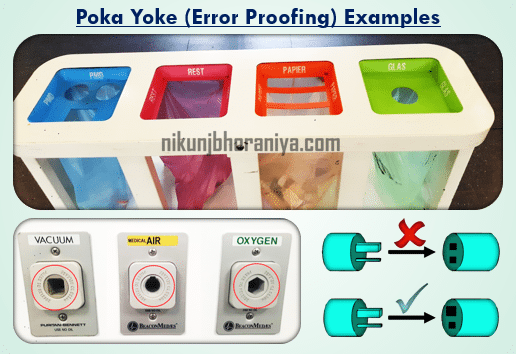What is Poka-yoke?
→ Poka-yoke means "error proofing" or "mistake-proofing". It came from the word "Poka" which means "mistake" and "Yokeru" which means "to avoid" and it is a Japanese term.→ It is any mechanism in any process that helps for "mistake-proofing" or "error-proofing".
→ We can eliminate product defects by preventing it, correcting it, or detecting is as they occur.
→ It is one of the Lean Manufacturing Tools
→ This concept was adopted, by Shigeo Shingo as part of the Toyota Production System.
→ Shigeo Shingo used the word "Poka_yoke" in the 1960s for the prevention of human error during industrial process design.
Poka-yoke Examples
→ A simple example is when we start a car having a manual gearbox, we must have to press on the clutch pedal before starting.→ This prevents us against the unintended movement or jerk of the car during the starting
→ Seat Belt wearing Indicator.
→ Auto-locking of the door at the certain speed of the car.
→ Bar code for correct product identification
How to implement Poka-Yoke in manufacturing?
→ It can be implemented at any step of the manufacturing process.→ We should implement this tool, where the possibility of something can go wrong or an error can be made.
→ It is a part of Lean Manufacturing
Steps of Poka-yoke Implementation:
- Identification Problems
- Prioritize
- Seek root cause
- Find and Implement solutions
- Measure the results
What are the types of poka-yoke?
→ Shigeo Shingo recognized three types for detecting and preventing errors in a process as mentioned below.- Contact Method
- Constant Number (or fixed-value) method
- Sequence (or motion step) method
The contact method:
→ The contact_method identifies defects using a part’s shape, color, size, and other physical attributes.→ It can also include limit switches and proximity sensors.
The constant number (or fixed-value) method:
→ When certain movements are not made then this error-proofing or mistake-proofing tool informs the operator this method is known as the constant number (or fixed-value) method.→ Counters can be used for this at each step of the process as necessary.
The sequence (or motion step) method:
→ This method ensures the sequence fo the process step before moving to the next step.→ This is known as the sequence (or motion step) method.
→ The sequence_method is not allowing the mistake to be made in the first place.
→ Example of sequence_method is color coding and tagging and this parameter are checked at each step before moving forward.
Poka-Yoke Principles
- Quality Processes
- Utilize a Team Environment
- Elimination of Errors
- Eliminate the Root Cause
- Do It Right The First Time
- Eliminate Non-Value Added Decisions and Activity
- Implement a Continual Improvement Approach
→ Make a robust process design for zero defect manufacturing.
[2] Utilize a Team Environment:
→ For any improvement, brainstorm with the teams so we can use their knowledge and experience to implement our improvement.
[3] Elimination of Errors:
→ Use various problem-solving methodologies or techniques for reducing defects and decrease defect to zero.
[4] Eliminate the Root Cause:
→ Eliminate the root cause of any problem by implementing this tool.
[5] Do It Right The First Time:
→ Make the process very effective to perform functions correctly for the first time.
[6] Eliminate Non-Value Added Decisions and Activity:
→ Identify all non-value added decisions and activities and eliminate them.
[7] Implement a Continual Improvement Approach:
→ We can not get 100% result in a single try.
→ So, implement improvement actions immediately and focus on continual improvements so we can get a 100% result.
Six Poka-Yoke Techniques Explained with Examples
- Elimination
- Replacement
- Prevention
- Facilitation
- Detection
- Mitigation
Elimination:
→ Primarily focus on elimination→ In Elimination, we have to eliminate the step that is responsible for the mistake
→ Remove Non-Value Added activities
→ Redesign the product and modification of the process (as applicable)
→ Examples: Replace manual data entry with barcode scanning
Replacement:
→ If elimination is not possible the second option is Replacement.→ In Replacement, we have to replace the step with a more reliable mistake-proof one
→ Automation of repetitive motion activities
→ Examples: Welding Robotics for an automotive manufacturer
Prevention:
→ If the above two methods are not possible then the 3rd option is prevention.→ Change product or process (as applicable) so that mistake is prevented.
→ Prevention is a physical barrier to prevent undesired action.
→ Examples: Safety guards on rides, Plugs for 110V & 220V, Printer cartridges and Go/No Go Gauges, etc...
Facilitation:
→ If the above three methods are not possible then the 4th option is facilitation.→ Facilitation is to help someone to take the right decision.
→ We can facilitate any process or product by visual controls like color coding, labels, lines, and signs, etc...
→ Examples: Warning signs, Checklists, Traffic lane markings, Color-coded parts or tools, etc...
Detection:
→ If the above four methods are not possible then the 5th option is facilitation.→ Detection is to identify or detect the wrong product or process immediately after it happens
→ We can provide detection by Sensors, limit switches, or light sensors
→ Examples: Safety guard limit switches to prevent machine running in an open condition, Computer warning if all information is not filled in
Mitigation:
→ If the above five methods are not possible then the 6th option is mitigation.→ Mitigation is to minimize the effects of mistakes or failures.
→ This method is used when the mistake cannot be eliminated
→ Examples: Personal protective equipment, Airbags in cars, Electrical Fuses, and An eraser on a pencil, etc...
Benefits of poka-yoke implementation:
→ Elimination of many operations related to quality control→ Increase the motivation of an employee
→ Reduce the overburden of operators from repetitive operations
→ A reduced number of rejects
→ Immediate action when a problem occurs
→ 100% built-in quality control.
→ Less time spent on training workers
→ Promotion of the work improvement-oriented approach
👉 See Also:






Dear Mr. Nikunj, the content is crisp. Would like to comfortably read the same. Would you pl send me a copy of the file. Tks. Gd day. Gopalakrishnan
ReplyDeleteThank you
DeleteDear Nikunj sir,
ReplyDeleteWill you please share Format of Poka yoke ,Error proofing for manufacturing .
Thank you for your input we will do this.
DeleteAbsolutely the best presentation. Very simple to understand. Thanks a lot. Keep up the great work!
ReplyDeleteThank you very much for your kind comment!!!
DeletePoka techniques how with : treat, tolerate, transfer and terminate statements?
ReplyDeleteHi thanks for sharing
Deletehow i can download file
ReplyDeleteIf you are facing any difficulty then you can reach us at contact@nikunjbhoraniya.com
DeletePost a Comment